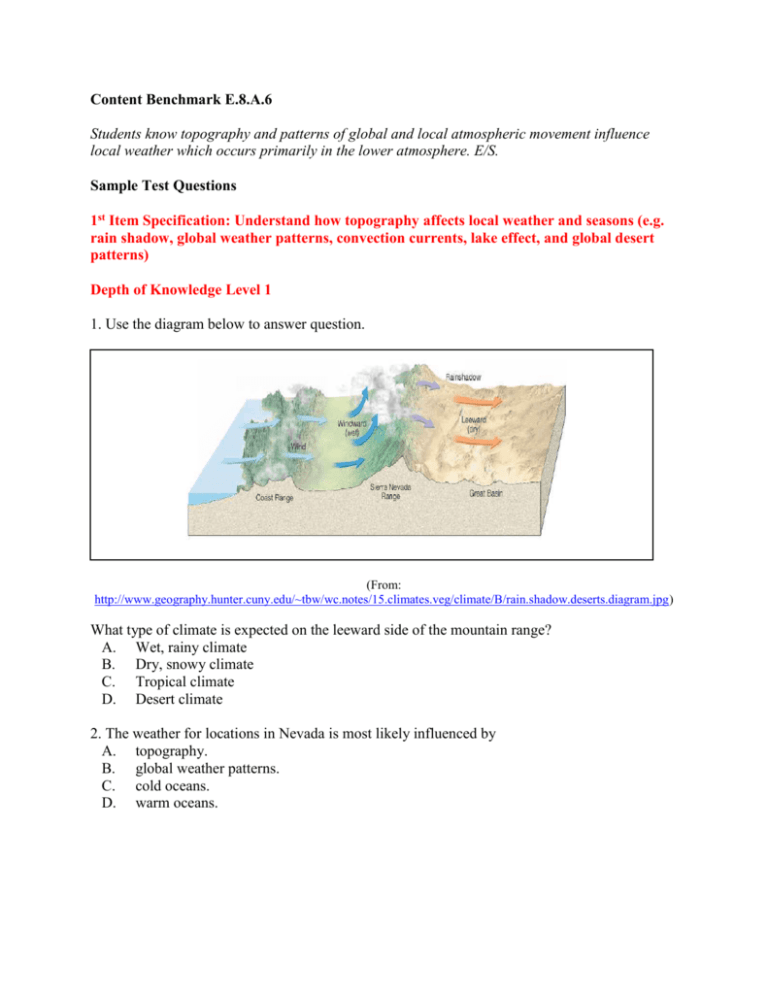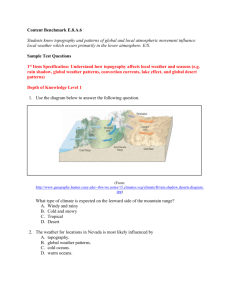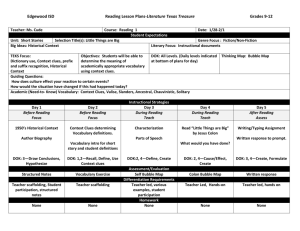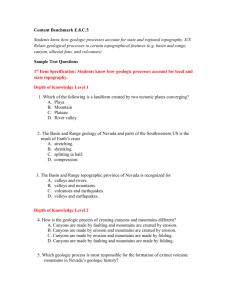E8A6_CRT_CR_MSTIPS_Final
advertisement

Content Benchmark E.8.A.6 Students know topography and patterns of global and local atmospheric movement influence local weather which occurs primarily in the lower atmosphere. E/S. Sample Test Questions 1st Item Specification: Understand how topography affects local weather and seasons (e.g. rain shadow, global weather patterns, convection currents, lake effect, and global desert patterns) Depth of Knowledge Level 1 1. Use the diagram below to answer question. (From: http://www.geography.hunter.cuny.edu/~tbw/wc.notes/15.climates.veg/climate/B/rain.shadow.deserts.diagram.jpg) What type of climate is expected on the leeward side of the mountain range? A. Wet, rainy climate B. Dry, snowy climate C. Tropical climate D. Desert climate 2. The weather for locations in Nevada is most likely influenced by A. topography. B. global weather patterns. C. cold oceans. D. warm oceans. 3. Use the diagram below to answer the following question. (From: http://www.fao.org/docrep/006/ad316e/AD316E79.gif) The diagram shows how prevailing winds cause different weather conditions on the windward and leeward side of a mountain range. Clouds usually form on the windward side because this is where air A. rises and cools. B. rises and warms. C. sinks and cools. D. sinks and warms. Depth of Knowledge Level 2 4. On average, mountains and valleys have different weather, in which mountains have A. less precipitation and warmer weather. B. more precipitation and warmer weather. C. more precipitation and cooler weather D. less precipitation and cooler weather. 5. The Sierra Nevada Mountains impact the weather of Nevada by causing A. rain shadows. B. tornadoes. C. hurricanes. D. Monsoon rains. 6. If the temperature and humidity on the western side of a large lake where compared to the eastern side of that lake on average it would be reasonable to expect A. both the temperature and humidity to be higher. B. the temperature to be high but the humidity lower. C. the temperature to be lower but the humidity higher D. both the temperature and humidity to be the same. 2nd Item Specification: Recognize that most weather take place in the part of the atmosphere closest to Earth. Depth of Knowledge Level 1 7. What is the height of the atmosphere layer in which weather occurs? A. 0 km B. 11 km C. 48 km D. 550 km 8. What is the layer of the atmosphere in which weather occurs? A. troposphere B. mesosphere C. exosphere D. stratosphere Depth of Knowledge Level 2 9. Use the following diagram to answer the question. The temperature profile of the Troposphere is most similar to the A. Exosphere. B. Mesosphere. C. Thermosphere. D. Stratosphere. 10. Use the following diagram to answer the question. Which combination of temperature and altitude is characteristic of the troposphere? A. -60°C/20 km B. -52°C/11 km C. 20°C/10km D. 52°C/11km Constructed Response E.8.A.6 Scale: 1 in. = 100 miles 1. Label the following places on the map: A – Nevada, B – Pacific Ocean and C – California. 2. Construct an appropriate graph utilizing all the data displayed in the table below. Month March April May June Average Temperature of Location 1 16 °C 18 °C 20 °C 24°C Average Temperature of Location 2 10 °C 15 °C 20 °C 40 °C 3. Based on the data table and graph, which city is most likely located near the ocean? Which city is located inland? Explain your answer. Content Benchmark E.8.A.6 Students know topography and patterns of global and local atmospheric movement influence local weather which occurs primarily in the lower atmosphere. E/S. Answers to Sample Test Questions 1. D, DOK level 1 2. A, DOK level 1 3. A, DOK level 1 4. C, DOK level 2 5. A, DOK level 2 6. B, DOK Level 2 7. B, DOK level 1 8. A, DOK level 1 9. B, DOK level 2 10. B, DOK level 2 Constructed Response E.8.A.6 Score Rubric: Temperature C Temperature at Location 1 and 2 vs. Months 60 40 20 0 1 2 3 4 Months Response addresses all parts of the question clearly and correctly. 3 points 2 points 1 point Locations A, B, and C are located in appropriate position on diagram. A double line graph is constructed which shows the temperature at two locations over four months. Location 1 is closest to the ocean as it moderates the temperature for the location. Location 2 is inland where there is a large range in temperature due to specific heat. Response addresses all parts of the question and includes only minor errors. Response does not address all parts of the question. 0 points The response is totally incorrect or no response provided.











